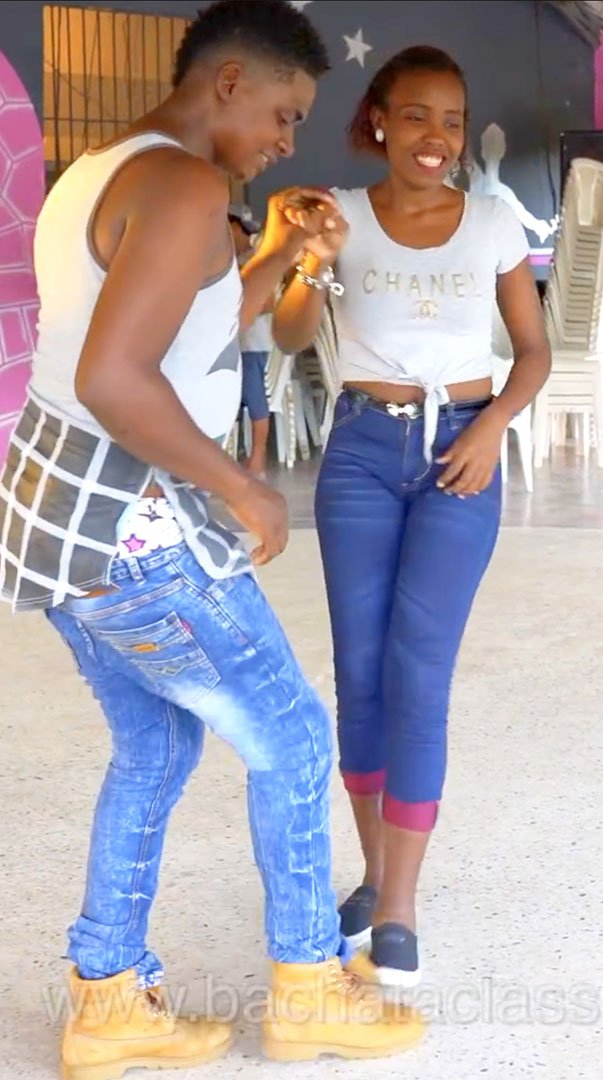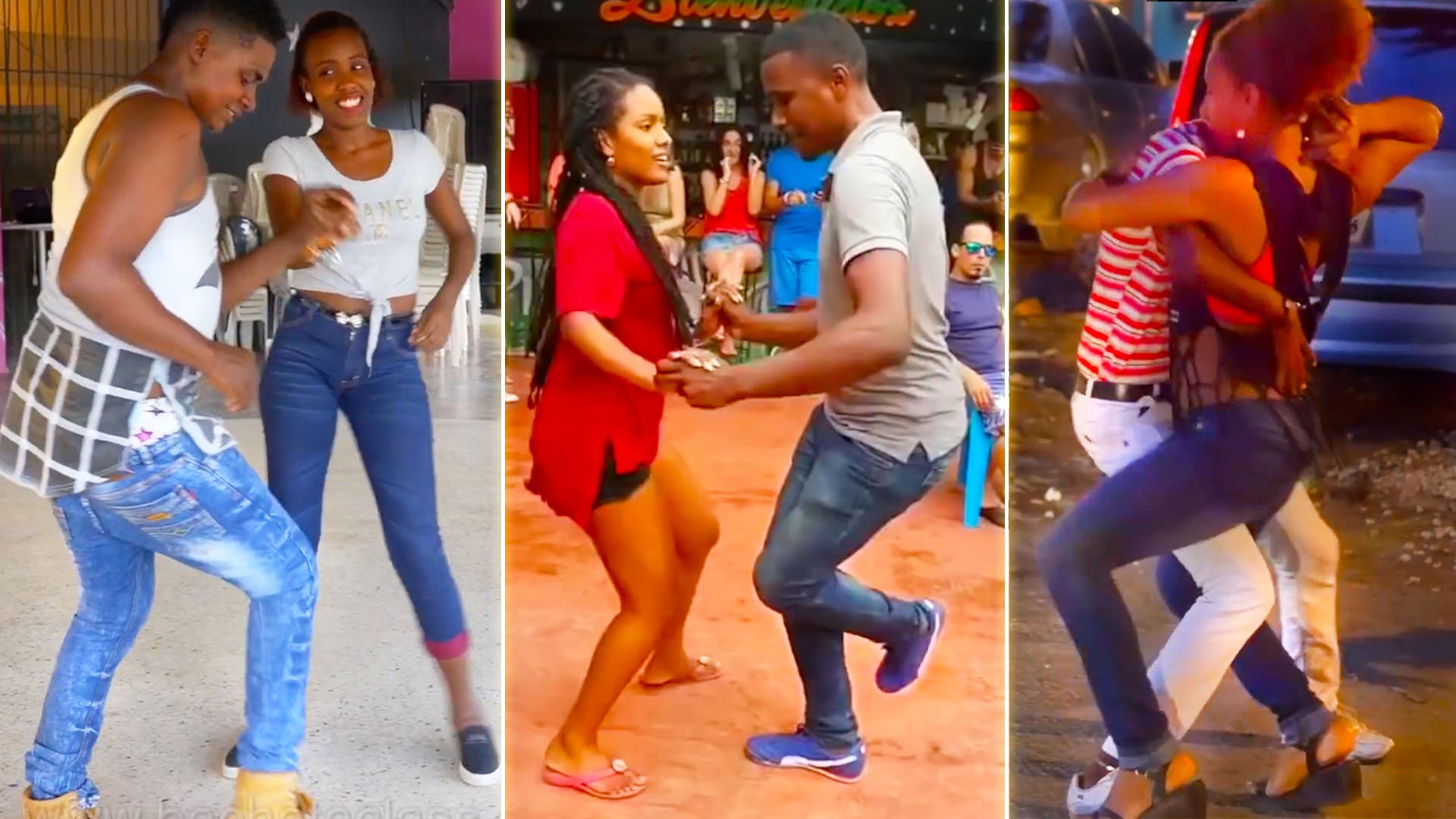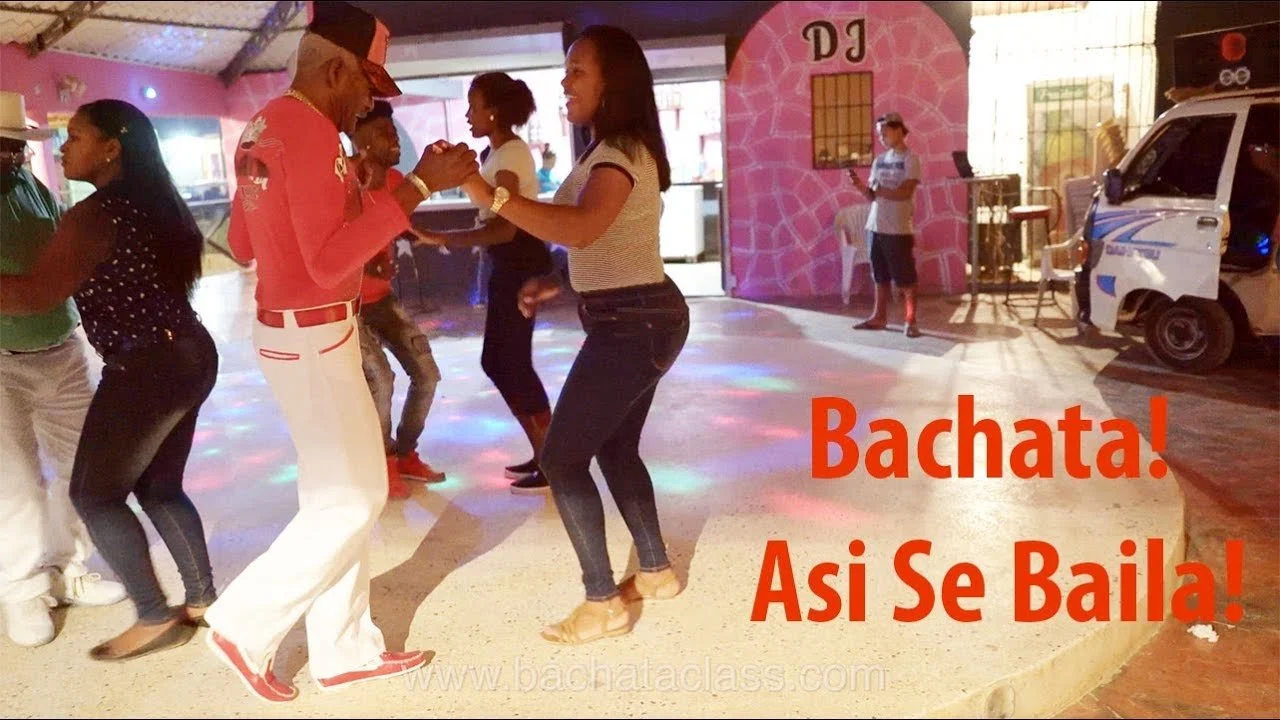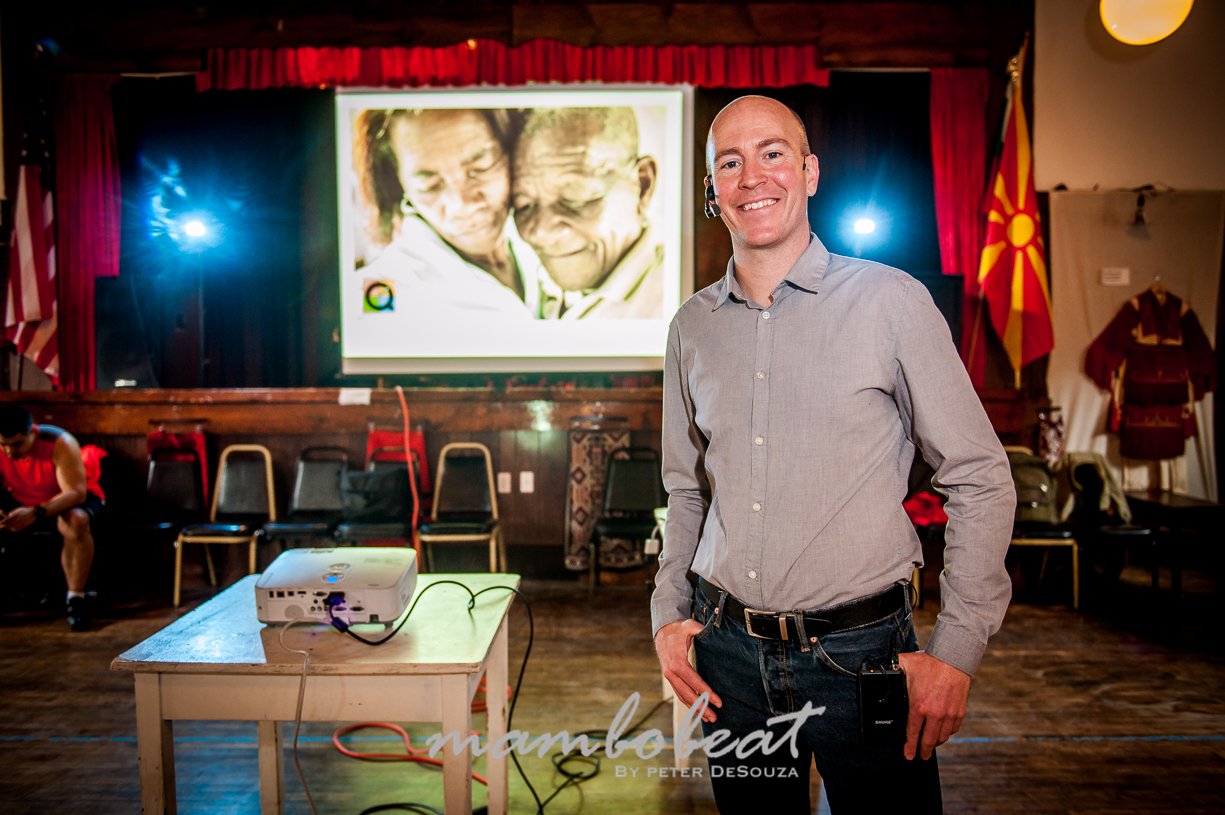What is Bachata Dance?
Bachata is a social dance from the Dominican Republic that is danced to Bachata music. It is an important part of Dominican culture, which has also gained tremendous popularity in many places around the world. Traditionally, it’s danced socially in partners of two, although it’s also common for people to dance Bachata solo informally. Bachata music is in 4/4 timing and the foundational or “basic” step is often described as 1,2,3, & “touch,” then stepping again in the other direction, 1,2,3 & “touch” for a total of 8 beats in total when combining each side. The “touch” may be a tap, touch, accent, or syncopated step such as “4&1.” Bachata dance in the Dominican Republic was heavily influenced by a variety of dances, principally Bolero, Son, and Merengue and you can see each of their influences in the frame, the shape of the foundational steps, the footwork, body motion, lead and follow, rotations and moves. Bachata is an active living dance in the DR so it continues to be influenced by other music and dance within the DR and abroad.
Bachata dancers in the Dominican Republic dance socially during the day and a open-air club. Here they are dancing in open position using a variety of steps.
Watch this video to learn some of what Bachata dance is and what it means in the Dominican Republic
Bachata dance and music in the Dominican Republic, its country of origin
Bachata in partners may be danced in a closed or open position with the 2 partners in physical contact all or most of the dance. Bachata is unchoreographed and incorporates a “lead and follow” within the dance, although it’s important to emphasize that both partners are creating and inspiring the dance, and expressing themselves with the music. Groundedness and weight transfer are important aspects of Bachata, and depending on the dancer’s personal and cultural style various amounts of hip motion may be seen during the steps. Bachata has traditionally not been taught formally in the Dominican Republic, rather it is passed on socially, within social dance settings, among families, and friends. Sociologists sometimes refer to this as a Vernacular dance, which is a dance developed 'organically' as a part of 'everyday' culture within a particular community. It developed as a social dance rather than as a performance-based dance. Bachata has not been codified or standardized within the Dominican Republic although its codification is happening more and more around the world as it is being taught formally in dance classes, online, and in festivals. As Bachata music and dance have traveled around the world many styles or ways of dancing to Bachata music have developed. For instance, in some countries, it’s common to see Salsa turns or dips when dancing to Bachata. Also common in some communities around the world are body rolls, movements, and moves from modern dance, Zouk, hip hop, and other genres. Many of these elements don’t exist within Bachata dance in the Dominican Republic. Though not traditionally a performance-based dance, it is now common to see Bachata dance performances at Bachata festivals around the world. Bachata dance in the DR (Dominican Republic) has many elements in common across the country and within the Dominican diaspora allowing people to share in the dance culturally, however, there is also a huge amount of personal styles and regional variations to it. There is no lack of diversity in how Bachata looks in the Dominican Republic! Also important to note is that not all Dominicans dance or like Bachata. In fact, it was once heavily marginalized within the DR and viewed as “low class.” Bachata dance developed alongside the creation and development of Bachata music as well. The song lyrics and the emotional feeling of the music often involve romantic relations such as love, heartbreak, longing, and desire and the feeling is an important part of the dance. Both Alegria and Amargue exist within the dance and music. Like many genres in the Caribbean, Bachata dance has African, European, and Indigenous American Influences. Although Bachata dance coalesced into its own dance in the Dominican Republic, but its important to acknowledge important contributions from people and communities outside the DR as well such as Haiti, Cuba, Puerto Rico, Colombia, and the USA,
The above definition is just our starting place from which we can begin to explore what is Bachata. The aim of this article is not to provide a final definition of what is Bachata dance but rather to serve as a starting point for further exploration.
Dancers enjoying themselves dancing Bachata in club, colmado and street in the Dominican Republic.
Bachata Dance Is Connected To Bachata Music
To understand Bachata dance one of the first places to start is to listen to Bachata music. Bachata along with Merengue are the two most prominent music from the Dominican Republic and are important parts of the culture and musical landscape. Bachata is listened to and danced to in a variety of social settings including colmados (small corner stores), bars, discos, cars, patios, and homes. Bachata derives from the Latin American tradition of guitar music. Bachata coalesced as a distinct Dominican genre of guitar music during the 60s and 70s with a different flavor than other Latin American bolero and guitar traditions. In the late 80s and early 90s the Bachata guitar electrified and was given effects to create the distinct sound we now recognize. When asked ‘what is Bachata’ many answer that Bachata is a feeling and a form of expression. Some may principally describe it as alegria or joy, while others describe it as amargue or the blues. Bachata can inspire people to dance, laugh, cry, smile, drink, reflect, or party. There are 5 essential instruments and a vocalist in Bachata music that include the lead guitar, rhythm guitar, bass, bongo, and güira. These instruments, their sounds, and their rhythms are a great inspiration to Bachata dancers. The various artists, eras, tempos, and styles of Bachata music and the changes that have occurred over the years have had an influence on the dance.
Watch These Bachata Couples dancing Bachata in the Dominican Republic to see the different ways it can look and be expressed
Couples dancing Bachata in various seeting and with a variety of styles in the Dominican Republic
How To Dance Bachata - The Foundations
There are many paths to learning to dance Bachata. As mentioned above, Bachata dance in the Dominican Republic has traditionally been learned socially, through friends, family, and going out to observe or dance, not through formal classes. This is a great way to learn Bachata! As Bachata has become popular around the world and in places that don’t have the same exposure to it, it has become common to see Bachata dance also taught in videos online, in classes, workshops, and festivals. Below is a video that teaches how to dance the “basic” Bachata box step.
Teaching the Bachata foundational basic box step
Bachata Dance Timing In the Dominican rEpublic Vs. How its often taught around the world
There are some big differences with how Bachata is danced in the Dominican Republic in comparison to how it is taught around the world. One of the biggest has to doing with Bachata dance rhythm and timing. When Bachata is taught around the world the vast majority of classes teach students to dance "on 1," taking their first step on the first beat of the music and then marking, tapping, or touching the 4th beat. There is nothing wrong with dancing on this timing, but in the DR dancers can, and will start on the 1, 2, 3, or 4 in the measure. It is normal to see a floor full of dancers in the DR dancing to multiple timings. Check out this video I filmed and made before reading on.
As you see in the video, in the DR dancing on multiple timings is not referred to as "on 1" "on 2" "on 3" or "on 4" but it is common to see all those timings danced. It is also very common to have the follow start the dance and thus determine the timing, which is another cultural difference in the dance.
Bachata Styles Around the World
As Bachata music and dance have traveled around the world many different ways of moving and dancing to the music have developed, some strongly rooted in Bachata from the DR and others vastly different. Some of these changes have happened organically, as the music traveled to different countries. The music was played in social spaces and people used dances that they already knew, fused with the little they knew about Bachata dance, to express themselves to the music. People hear the music and what to dance to it! When Bachata music enters a new space it doesn’t necessarily mean that there are Dominicans that dance the Bachata in that community so at times there is very little reference of how it is danced in the DR. Dancers may use some elements of what they have seen others do while also adapting genres that they already dance to fit the music.
People dance Bachata in the DR and abroad for a variety of reasons. To enjoy and express their connection with the music, to socialize, to be part of a community, as exercise, as self-expression, or as something to do to meet or connect with a romantic partner. Bachata was an intensely marginalized music in the Dominican Republic that has now gained widespread acceptance and love and home and around the world. This is a source of pride for many Dominicans. Bachata has become for many around the world a way to express what they feel in the music, a way to socialize, and a chance to be part of a community. This widespread acceptance, and the changes that have accompanied it have also become a source of tension and critique from many Dominicans, who sometimes see part of their culture misrepresented.
Fusions have developed and have spread through dance classes, workshops, festivals, dance teachers, performances, and videos. Some of this happens organically while in other cases with the growth of a Bachata dance economy worldwide, there are efforts to promote, spread and develop certain styles. In addition, the surge in Bachata remixes and the trend of dancing “Bachata” to non-Bachata music has pushed style changes to a great degree, especially within what is called Sensual Bachata or Sensual. There continues to be dialog over the balance between respect and appreciation of a culture’s dance and the changes that may and understandably come with a living organic form as other people and cultures engage with it. The conversation between where is the line between appreciation and acceptance and appropriation and disrespect is an important one.
Many debates have started over what is and what is not Bachata dance. There are many nuances to these debates which will be delved into in a future blog. Certainly, we can say that Bachata music and dance are enjoying great popularity around the world in many places where it was not listened to before. It is also true to say that many Dominicans don’t recognize some of the ways it is danced abroad as “authentic” Bachata dance. Some believe these new styles are natural developments in Bachata and that these new forms continue in the Bachata family while others believe that they have changed to such a great extent that they have branched off into something new, a new dance genre. This blog doesn’t attempt to settle these debates but hopefully will provide some context for thinking about them.
Bachata Styles Vocab
Bachata - The name of the dance and music genre in the Dominican Republic. Traditionally Dominicans have not added words such as “Dominicana” or “Dominican” to Bachata when talking about the dance or music within the country. They do not normally say “Dominican Bachata” when talking about Bachata in the DR, simply “Bachata.” This may be changing to some extent, especially online as people try and search and find videos or dance and music from the DR. But basically Bachata suffices and is enough to describe the dance and music.
Dominican Bachata or Bachata Dominicana - This term largely developed outside of the DR as Bachata was taught in classes and festivals around the world. The term was used to differentiate itself from other styles being taught such as Modern, Urban, Bachatango, Sensual, etc. The term points to the teaching or dancing of elements and roots from the Dominican Republic but sometimes has meant that the Bachata dance described will have or focus on fast footwork. I personally used the term “Dominican Bachata” at times to try and let students know that we would focus on elements from the DR or to help teach people to learn where Bachata was from. Interestingly, within the Dominican Republic, as they applied for UNESCO tangible cultural heritage recognition they sought to label it as “Dominican Bachata” seeking to solidify the Dominican Republic as Bachata's country of origin. Other terms like “Traditional Bachata” and “Authentic Bachata” have also been used in an attempt to label Bachata dance from the Dominican Republic and differentiate it from other styles of Bachata outside of the DR.
Modern Bachata - The term Modern Bachata when talking of the dance normally means the inclusion of moves such as turn Salsa turn patterns, dips, hammerlocks, stops, and body rolls. This style largely developed in the USA, Europe, and Australia. The side basic is often taught as the foundation of Modern Bachata. As Bachata dance was taught around the world it became exceedingly common for it to be taught and danced only “on 1.” It is taught that the first step of the basic must start on the “1” of the music and the tap or touch must happen on the 4th beat of the music. In the Dominican Republic and in many Latin American communities that have not learned Bachata in classes this “rule” of dancing Bachata “on 1” does not exist. It was also common to hear the term “Urban Bachata” to describe a type of Modern Bachata with more emphasis being placed on pops and moves popular in hip-hop dance. Modern Bachata was heavily influenced by the emergence of Bachata performances at festivals, Bachata competitions, online videos, and Bachata teachers that also had experience with dancing and teaching Salsa. It was also influenced by the process of formally teaching the dance, with teachers always searching for new moves to teach. Also, many of the dancers and teachers dancing and creating Modern Bachata did not have an extensive connection with the Dominican Republic at the time of its development.
Sensual Bachata - Sensual Bachata, sometimes just called Sensual as we know it today was developed in Spain by a number of prominent dance teachers. influenced by Modern Bachata, Zouk, and other genres. It’s important to note that the term was also used separately to describe and label other styles of Bachata in the USA prior to the Sensual Bachata surge worldwide. Sensual Bachata from Spain uses many moves not found in Bachata in the DR such as body rolls, stops, pauses, leads of the follows torso or head using the hands, body isolations, folding or bending over the follow, etc. Body waves similar to Brazilian Zouk, upper body isolations, as well as tricks also form this style. It is also very influenced by performances at festivals, classes, and online. Bachata Sensual, was developed during the surge of English language Bachata remixes. The vocal tracks of English language pop were remixed with mostly digitally created bongo beats and other instrumentation to create Bachata remixes. It also became common to dance Sensual to non-Bachata music. The dance looks very different from Bachata in the Dominican Republic. A dancer with purely Sensual Bachata experience would have great difficulty social dancing Bachata in the Dominican Republic and likewise, a Bachata dancer from the DR would have difficulty social dancing in a Sensual Bachata social.
Ballroom Bachata - A style of Bachata that has emerged as formal ballroom and ballroom teachers have began to teach Bachata. includes many elements and posturing seen in the dances of ballroom Rumba and Ballroom Cha Cha Cha etc.
Performance Bachata - As festivals became popular Bachata performances by couples, individuals, and dance teams became popular. Many performative elements, including lifts, tricks, throws are incorporated. These at times have crossed over to social dance. Also with the expansion of social media like Facebook, Youtube, Instagram, and TikTok Solo Bachata performances and Couples performances have gained tremendous popularity. These social performances have also influenced social dance style and how Bachata dance is perceived. Athletic Bachata such as Bachata for Zumba or for exercise classes has also developed around the world.
A variety of Bachata dance styles have developed around the world. It’s easy to disregard all of the organic changes that happen and styles that develop on a regional level around the world. Take two for instance, Bachata Pacheco in Venezuela and Bachata Gujira in Puerto Rico. But there are many more instances.
Dancing Bachata
How Did Bachata Dance Originate?
Although we say Bachata is from the Dominican Republic and Bachata dance and music coalesced into its own genre in the Dominican Republic it is not purely Dominican. It has had, and continues to have a variety of influences from other countries, people and cultures. How a person answers the question of when, where and how Bachata originated is largely determined with how they define Bachata, and at what point in its development they believe it “became Bachata” from its earlier music and dance relatives such at Bolero. For instance, for one of the early Bachata musicians, Edilio Paredes he believes views Bachata as part of the Latin American musical tradition that already exisited outside the DR and so tends to frame it that Dominicans did not invent Bachata. Where is other musicians such as Jose Manuel Calderon or Luis Segura tend to lean into the recordings they did in the 60’s being somehow unique and in a sense the birth of Bachata. Others might look ahead to the 70’s when the term Bachata was first used to describe the genre as the time when it was really born and still other might look toward the 80’s when it was electrified as the time it coalesced.
Because we don’t have a lot of interviews or videos about Bachata dance from the 60’s, 70’s and 80’s a lot of this info must be gained from interviewing dancers and musicians who were around then and by also watching the older dancers now. In addition, we can make assumptions and hypotheses based on what we know about the music and dance genres that were present in the DR during Bachatas rise. In many ways, Bachata derives from the dances Bolero and Son. Its was also heavily influenced by Merengue both musically and in the dance. The early Dominican guitar music from the 60’s that we now call Bachata was actually at the time called Bolero or Musica de Guitarra. It was not until probably the 70’s that the term Bachata was used to describe the genre. So we can surmise that the way people were dancing to early Bachata was how they danced to Bolero Campesino and Son. When I interviewed Cande, Joan’s Dad about music and dance when he was growing up dancing in the 50’s and early 60’s he said that there was no Bachata then. He said what they had was Bolero, Son Montuno, Merengue de Accordion. So these were what Cande danced so we can get clues by looking at how he danced Bachata. I have included some videos below showing some older dancers dancing Bachata to get clues on how early Bachata may have looked. It’s worth noting however from interviews that early Bachata was probably mostly danced in a close embrace in closed position. Then over time, and perhaps in family gatherings as well or among friends, and as the music temp varied to include more up-tempo Bachata within the catalog it became more common to dance in open positions as well.
Cande Severino dances Merengue and Bachata in his patio in the DR. Cande grew up dancing Merengue, Bolero, Son Montuno and Guaracha before Bachata existed and this video may give clues to Bachata dances development
Here in red we see a dancer who was around and dancing during Bachatas early days and perhaps will give insight to how Bachata dance was created
Blog post by Adam Taub
Adam is a documentary filmmaker who has completed a number of projects in the Dominican Republic. He has lived in the Dominican Republic and conducted extensive research, in-depth video projects, and recorded interviews with bachata legends. He has engaged in research projects exploring bachata dance in the Dominican Republic, New York City, and around the world.
Adam is widely recognized for his innovative presentations and the unique pedagogy he has developed for teaching bachata dance and musicology. Adam has been invited to teach and present his work at dozens of national and international salsa and bachata festivals, libraries, cultural centers, and universities.





